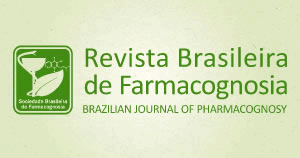Resumo em Português:
Neste trabalho foram estudados os efeitos do extrato aquoso (EA) obtido das folhas da Hyptis pectinata sobre o sistema nervoso central de roedores. Os seguintes modelos experimentais foram utilizados em camundongos, machos e fêmeas, da linhagem Wistar: "screening" farmacológico, campo aberto, nado forçado, hipotermia induzida por apomorfina, labirinto em cruz elevado e tempo de sono induzido por tiopental. O extrato foi administrado por via oral em dose única, 30 minutos antes de cada teste. No "screening" farmacológico o EA (400 mg/kg, p.o., n = 3) diminuiu a freqüência do comportamento de auto-limpeza. No teste do campo aberto o EA diminuiu o tempo gasto em auto-limpeza (AE400: 51,3 ± 8,8, q = 5,513, P < 0.01, n = 10) de maneira similar ao diazepam (control: 107,3 ± 14,2; diazepam: 15,4 ± 4,3, q = 9,049, P < 0.001, n = 10). No teste do nado forçado o EA (400 mg/kg) diminuiu o tempo de imobilidade (con: 181,3 ± 7,2 s; imip: 91,6 ± 8,9 s, q = 7,958, P < 0,001; AE400: 111,6 ± 14,5 s, q = 6,193, P < 0,001, n = 9) indicando um possível efeito antidepressivo. Isto foi confirmado no modelo de hipotermia induzida pela apomorfina onde o EA (200 mg/kg) antagonizou o efeito da apomorfina (AE200: -0,27 ºC, q = 5,588, P < 0,001, n = 10) de maneira similar à imipramina (5 mg/kg) (control: -1,08 ºC; imipramine: 0,02 ºC, q = 7,589, P < 0,001, n = 10). Nenhum efeito do EA foi observado nos testes do labirinto em cruz elevado e do tempo de sono induzido por tiopental. Nossos resultados sugerem um possível efeito antidepressivo do extrato aquoso obtido das folhas da Hyptis pectinata.
Resumo em Inglês:
The effects of the aqueous extract (AE) from Hyptis pectinata leaves was studied on rodent central nervous system (CNS). Pharmacological screening, open field, forced swimming, apomorphine-induced hypothermia, elevated plus maze and thiopental-induced sleep tests were used in male and female Swiss mice and Wistar rats. The AE was admnistered orally in single doses 30 minutes before each test. In the screening test the AE (400 mg/kg, p.o., n =3) decreased the frequency of grooming behavior. In the open field test it decreased the amount of time rats spent grooming (AE400: 51.3 ± 8.8, q = 5.513, P < 0.01, n = 10), similarly to diazepam (control: 107.3 ± 14.2; diazepam: 15.4 ± 4.3, q = 9.049, P < 0.001, n = 10). In the forced swimming test the AE (400 mg/kg) decreased the immobility time (con: 181.3 ± 7.2 s; imip: 91.6 ± 8.9 s, q = 7.958, P < 0.001; AE400: 111.6 ± 14.5 s, q = 6.193, P < 0.001, n = 9), indicating a possible antidepressive effect. This was confirmed in the apomorphine-induced hypothermia model where the extract (200 mg/kg) antagonized the apomorphine effect (AE200: -0.27 ºC, q = 5.588, P < 0.001, n = 10), similarly to imipramine (imipramine: 5 mg/kg) (control: -1.08 ºC; imipramine: 0.02 ºC, q = 7.589, P < 0.001, n = 10). No effect of the AE was detected in the elevated plus maze and in the sleeping time induced by thiopental models. Our results suggest a possible antidepressive effect of the aqueous extract obtained from the leaves of Hyptis pectinata.
